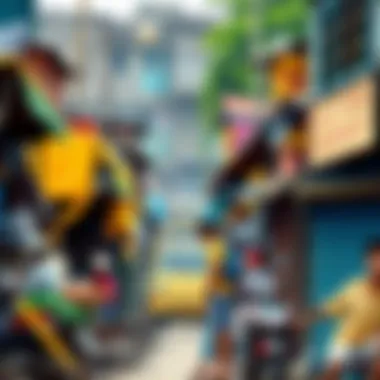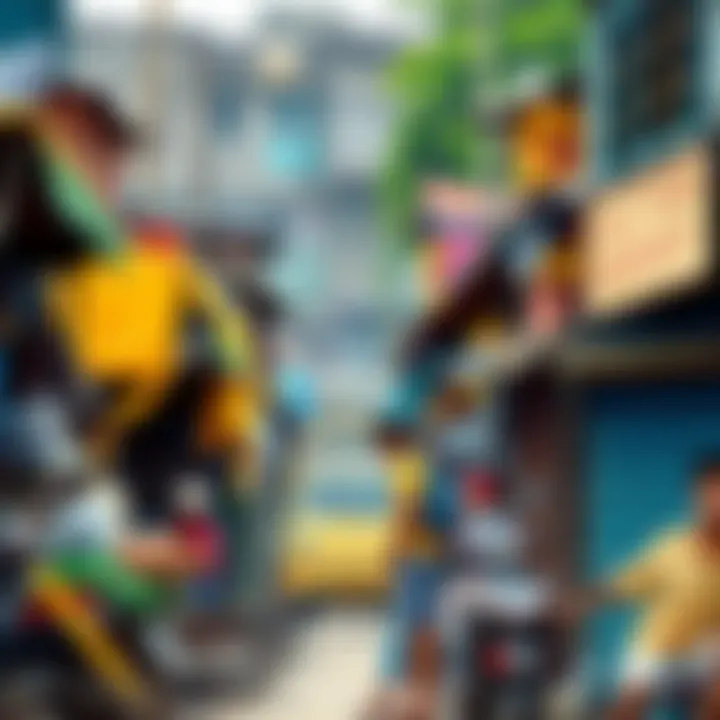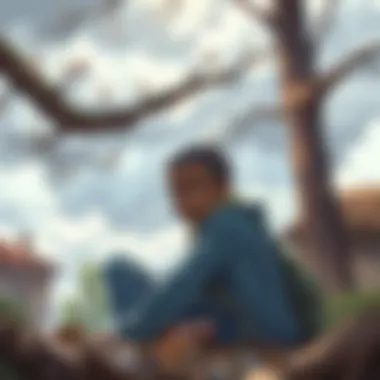Exploring Themes and Characters in Boo's Masterpiece


Intro
Katherine Boo’s 'Behind the Beautiful Forevers' paints a vibrant yet sobering portrait of life in the slums of Mumbai. This narrative explores the intersection of aspiration and despair, revealing how dreams are forged and often thwarted by socio-economic realities. In this piece, we will uncover not only the intricate character studies but also the broad themes that Boo navigates with deftness. The aim is to enhance our understanding of her work while bolstering a deeper conversation regarding poverty and resilience.
Categories of Life-Changing Books
In the landscape of literature, some books stand as pillars of insight, and 'Behind the Beautiful Forevers' certainly belongs to this realm. It fosters discussions beyond mere story-telling and ventures into the realms of personal development and transformative experiences.
Self-Help and Personal Development
While this book primarily offers a gripping narrative, it also holds several lessons on personal growth. Boo captures the tenacity of her characters, highlighting how individual determination can emerge from the direst situations. For instance, the stories of Asha, a woman fighting against the odds to become a power broker within her community, demonstrate how one can navigate through systemic obstacles, offering a powerful testament to the human spirit.
Fiction with Transformative Themes
In contrasting the lifestyles of slum inhabitants with those living in wealthier areas, Boo invites us to rethink our perceptions of success and happiness. The characters are not merely subjects of tragedy; they embody resilience and hopes. Through their journeys, readers come to understand that transformative themes often lie in the struggle for dignity and survival.
Book Summaries and Insights
To fully appreciate Boo's work, it's vital to distill its most significant insights. This section offers key takeaways and approaches for applying these lessons to everyday life.
Key Takeaways from Popular Titles
- Human Connection: Relationships in the slum are intricately tied to survival. Each character's interaction reveals how communal ties can offer both support and conflict.
- Dreams vs. Reality: The clash between aspirations and harsh living conditions serves as a backdrop, reminding readers that dreams often come at a cost.
- Class Disparity: The juxtaposition of lifestyles highlights the stark differences in opportunity based on socio-economic status. Boo gives a voice to those often unheard.
How to Apply Insights in Daily Life
Readers can take Boo’s insights and reflect on their individual circumstances:
- Cultivate Empathy: Understanding others’ struggles can deepen personal connections and foster community.
- Challenge Preconceptions: Recognize that everyone’s path is uniquely shaped by their environment.
- Value Resilience: Embracing challenges can lead to personal growth, whether one faces minor setbacks or significant life changes.
"Katherine Boo illustrates that the relentless pursuit of dignity can shine through even the darkest circumstances."
In summary, 'Behind the Beautiful Forevers' serves more than an account of lives lived in a Mumbai slum; it is a study in resilience, humanity, and the complexities that shape our existence. By examining these layers, we come to understand not just the characters but perhaps ourselves in the framework of societal challenges.
For more information on the context of Boo's work and further exploration of socio-economic issues, visit resources like Britannica and Wikipedia. Furthermore, conversations surrounding poverty and resilience can be found on Reddit or in academic tones on .edu pages.
Intro to 'Behind the Beautiful Forevers'
In the realm of contemporary literature, 'Behind the Beautiful Forevers' stands out as a piercing lens into the heart of societal contrasts lodged within the framework of modern Mumbai. Katherine Boo's meditation on life in the slums of Annawadi grapples with crucial themes that resonate well beyond its setting. This work is not merely a recounting of hardship; it presents a multifaceted narrative that invites readers to question the very essence of hope and despair amidst grinding poverty. By exploring components such as economic disparity, social dynamics, and individual aspirations, Boo crafts a tapestry that is both heartbreaking and illuminating.
Understanding 'Behind the Beautiful Forevers' is like peeling an onion; each layer reveals not only the harsh realities faced by its characters but also reflects on broader human experiences. One must consider the intersection of narrative style and character development, as they play critical roles in unearthing the motivations that drive individuals within this complex ecosystem. The significance of this text extends into discussions about resilience and survival—concepts that spark dialogue about how environments shape human behavior.
Overall, this section serves as a vital entrance point for readers seeking to grasp the nuances embedded within the work. By examining Boo's background and narrative approach, we set the stage for a deeper engagement with the material. This richer analysis will appeal to students, professionals, and avid readers alike, igniting curiosity about the human condition and our collective quest for dignity amidst adversity.
Author's Background and Perspective
Katherine Boo's journey as a journalist and author informs her empathetic yet unvarnished portrayal of life in Annawadi. Raised in a suburban neighborhood that could not be more different from the vibrant chaos of Mumbai, her perspective is one shaped by contrast. Boo's previous work in documentary photography and reporting lends authenticity to her writing, giving voice to those often left unheard.
Her research, rooted in in-depth field studies, extends over several years. This extended engagement allowed her to develop relationships with residents, capturing both their stories and struggles with an impressive degree of understanding and respect. One cannot overlook that Boo's experience with the New Yorker and her exposure to global narratives enable her to place the struggles of Annawadi within a wider context of urban poverty.
Boo's ability to skilfully weave her lived experiences into the narrative reinforces its impact. For example, her decision to live in close quarters with her subjects provides a lens that combines journalistic integrity with narrative artistry. The author's nuanced perspective is vital; she does not portray Annawadi merely as a place of squalor but as a vibrant community full of individuals brimming with dreams and ambitions.
Overview of the Narrative Structure
The narrative structure of 'Behind the Beautiful Forevers' mirrors the complex web of interconnected lives within the slum. Unlike conventional plots, Boo opts for a non-linear approach, allowing themes and character arcs to emerge organically rather than through a traditional beginning, middle, and end. Each chapter often focuses on the perspective of different characters, providing readers with a kaleidoscopic view of Annawadi's social fabric.
Each character's journey is interlaced with the stories of others, showcasing the intertwined fates of those striving for a better life, be it through politics, perseverance, or sheer luck. This method creates a symphonic effect where the resonance of one story amplifies another, enhancing the overall emotional weight.
Furthermore, Boo employs immersive descriptions that extend beyond the physical surroundings of Annawadi. The slum is not merely a backdrop; it comes alive through vivid imagery and sensory details, making readers feel the heat, the sounds, and the very real stakes at play. As a result, the book becomes more than a simple observation—it transforms into an evocative experience that leaves an imprint on the reader's psyche.


By weaving together individual stories into a collective narrative, Boo encapsulates the struggles and triumphs inherent to the human experience. This structure, layered with insights and reflections, encourages readers to ponder their own understandings of community, resilience, and humanity.
Setting the Stage: The Context of Mumbai
Katherine Boo's exploration of the Mumbai slum through Behind the Beautiful Forevers provides a lens into the socio-economic intricacies of a rapidly changing metropolis. To appreciate the depth of Boo's narrative, one must first understand the context of Mumbai, particularly Annawadi, where the story unfolds. This vibrant yet harsh landscape is not just a backdrop; it is a critical character in its own right, influencing the lives and dreams of those who inhabit it.
The Geography of Annawadi
Annawadi, situated near the bustling Chhatrapati Shivaji Maharaj International Airport, might seem like an improbable setting for a story about resilience and ambition. Close to gleaming skyscrapers, this slum is a stark contrast to the affluence that surrounds it. The geography plays a vital role in shaping the experiences of its residents. Narrow lanes littered with refuse create a maze that reflects both challenges and the ingenuity required for survival. Boo vividly describes how families build homes from scrap and garbage, reflecting a relentless spirit to flourish against overwhelming odds.
The proximity to wealth offers a bittersweet irony, where dreams often intertwine with despair. The air is thick with pollution, not just from the physical trash but also from the societal stratifications that prevent upward mobility. Here, the geography is not merely about physical location; it extends into the economic and emotional terrains that characters must navigate daily. The struggle for space, both literally and metaphorically, defines the essence of life in Annawadi.
Cultural Dynamics within the Neighborhood
In Annawadi, the cultural dynamics are as intricate as the physical geography. Diverse groups coexist, each with their unique traditions and aspirations, yet bound by the common thread of trying to survive in a formidable environment. The interactions among different communities shape the social fabric, often leading to alliances and rivalries, which can ripple through the narrative Boo crafts.
The narrative reveals how religion, caste, and local politics interplay within this densely populated space. For instance, competitions for resources and opportunities often root themselves in cultural differences, sometimes escalating tensions between groups. The characters reflect this complexity, with Asha, Abdul, and Sunil embodying distinct cultural narratives.
Furthermore, cultural celebrations in Annawadi provide glimpses of hope and unity amid the challenges. Festivals, despite their simplicity, become occasions for residents to escape their daily struggles and find joy in community. These moments are essential, as they remind both the characters and readers of the resilience and vibrancy that exists even in despair.
"Navigating the delicate web of cultural dynamics in Annawadi reveals not just struggles but also the shared humanity among its inhabitants."
A nuanced understanding of these social elements enhances one’s comprehension of Boo's portrayal of life in Annawadi and underscores the broader socio-economic realities represented in Behind the Beautiful Forevers. The context of Mumbai, particularly Annawadi, is pivotal, establishing the groundwork for the narratives of poverty, aspiration, and survival that resonate throughout the work.
Character Analysis
Understanding the characters in 'Behind the Beautiful Forevers' is pivotal for grasping the depth of Katherine Boo's narrative. Each character embodies unique struggles and aspirations reflective of the broader socio-economic context within Mumbai's slums. Boo intricately depicts how environmental factors shape individual destinies, making each character's journey relevant for readers interested in social justice and human resilience. By peeling back the layers of these lives, the analysis reveals insights into systemic issues like poverty, corruption, and the pursuit of hope amidst despair.
Asha: The Aspiring Politician
Asha, one of the primary figures in the narrative, represents the intersection of ambition and the grim realities that surround her. Her desire to enter politics is not born out of mere aspiration, but from a deeply ingrained understanding of her environment. Asha often finds herself navigating the treacherous waters of power and influence within Annawadi.
Through Asha, Boo paints a vivid portrait of a woman who is not just trying to rise above her circumstances but is also plotting to use her position to impact her community. It's crucial to see her not merely as an individual, but as a symbol of many women who strive for agency and recognition in a male-dominated society.
Asha’s character is layered; she often wrestles with ethical dilemmas and the corrupt nature of the political landscape. Her journey highlights a key theme in Boo's work: the complex relationship between personal ambition and social responsibility.
Abdul: Dreams of a Better Future
Abdul's narrative is rooted in the quest for a brighter tomorrow. His character grapples with the stark realities of survival while holding onto an idealistic vision of success. As a young boy, Abdul dreams of a life beyond the confines of Annawadi. He serves as a mirror to the aspirations of many who live in similar locales; dreams of education and improved living conditions are common yet often feel just out of reach.
Abdul's relationship with his family and peers amplifies the struggles of youth in slums. He faces not only societal expectations but also internal conflicts stemming from his dreams versus his current reality. His journey is emblematic of the broader struggles faced by youth, illustrating how their potential becomes entwined with the socio-economic fabric of their surroundings.
Sunil: The Harsh Reality of Youth
Sunil embodies the often-overlooked plight of youth in impoverished urban settings. His experiences serve as a stark reminder of how socio-economic conditions can stifle young ambitions. While others around him are driven by dreams, Sunil becomes a victim of circumstance, drifting through life without a clear path.
Boo captures his struggles with poignant detail, portraying Sunil as a symbol of those who are left behind in the fast-paced world of Mumbai. His character raises critical questions about agency and the choices available to the disenfranchised. In a way, Sunil is a cautionary tale of how systemic barriers can crush potential and leave one in a cycle of despair.
Through these characters, Boo doesn’t just tell individual stories; she weaves a narrative that reflects the broader tapestry of life in Annawadi, enriching the reader's understanding of humanity's resilience against overwhelming odds.
Major Themes in the Narrative
In "Behind the Beautiful Forevers," Katherine Boo tackles complex issues that permeate society, particularly within the context of Mumbai's slums. The narratives interwoven throughout the lives of the characters serve as a vessel to explore fundamental themes that resonate not only with the individuals in the story but also with a broader audience. Notably, themes such as Poverty and Survival, Corruption and Bureaucracy, and Hope Amidst Despair are crucial for understanding the stark realities of life in Annawadi. By examining these elements, readers gain insight into the multifaceted struggles faced by marginalized communities and the resilience exhibited by the human spirit.
Poverty and Survival
Poverty is perhaps the most overt theme in Boo's work, painting a bleak picture of day-to-day existence for the characters in Annawadi. Life is a constant battle for Abdul, Asha, Sunil, and their neighbors, where basic needs like food and shelter are precarious. The nuance of their survival strategies is highlighted as they navigate a scrappy economy based on waste collection and recycling.
- Resourcefulness: Rather than merely depicting hardship, Boo illustrates how impoverished families adapt. For instance, Asha's attempts to secure political connections manifest the lengths one will go for a glimmer of stability. Her relatability emerges through her struggles to balance ambition with survival.
- Daily Challenges: The narrative does not shy away from portraying the filthy and unforgiving realities of their environment, with descriptions of the squalor serving to remind readers of the everyday struggles faced by inhabitants of slums around the world. Boo’s focus on the mundane can feel like a slap in the face to comfortable readers, forcing recognition of a reality too often ignored.
Corruption and Bureaucracy


Corruption plays a significant role in shaping the characters' lives, reflecting the systemic failures that entrench poverty and perpetuate despair. The bureaucratic machinery in India, as depicted in Boo’s observations, is mired in inefficiency and self-interest, often blocking any potential for progress or aid for the people of Annawadi.
- Interpersonal Relationships: The connections between citizens and government officials often resemble a game of power rather than a means for positive social change. Boo emphasizes how Asha seeks to manipulate these relationships, highlighting the transactional nature of corruption where loyalty is bought and sold.
- Cynicism of Systems: Readers become acutely aware of the emotional toll that such red tape takes on the community. When characters apply for basic benefits or seek assistance, their experiences are fraught with denial and neglect, showcasing a system that fails to respect the dignity of the very people it is meant to serve.
Hope Amidst Despair
Amid the stark realities, the theme of hope shines through the narrative like a flickering candle in the darkest corners of Annawadi. This element serves to humanize the characters, offering poignant insights into their dreams and aspirations despite looming socio-economic barriers.
- Aspirations of Youth: Abdul's desire for education exemplifies a desire for something beyond immediate survival; he dreams of being a mechanical engineer, a simple yet profound wish that embodies hope. The youth's naivety contrasts with their harsh surroundings, revealing a determination that resonates deeply with readers.
- Community Resilience: Furthermore, Boo illustrates the strength found within the community, as neighbors band together during crises. This solidarity can lead to moments of joy and relief that punctuate the otherwise bleak narrative, reinforcing the message that hope is a powerful motivator even in the direst circumstances.
"In the ruins of their lives, the people of Annawadi craft dreams that stand tall, defying the harshest of realities."
In sum, these themes are not just narrative devices; they echo the lived experiences of many, transcending the specific context of Mumbai's slums. Boo’s narrative challenges readers to confront uncomfortable truths about society and inspires an empathy that can lead to broader social understanding.
Narrative Techniques Employed by Boo
Katherine Boo's narrative in Behind the Beautiful Forevers is far from a mere recounting of events; it’s a finely tuned instrument that captures the essence of life in a Mumbai slum. Boo's techniques are pivotal for weaving together the stories of various characters who navigate a landscape rife with poverty, ambition, and resilience. To ensure readers grasp the depth of the socio-economic realities presented, she employs methods that resonate with both emotional weight and cultural authenticity.
One significant aspect of her style is the use of immersive descriptions that transport readers directly into the fabric of Annawadi. Her vivid portrayal of both the sights and sounds of this community not only illustrates the physical environment but also reflects the internal struggles of its inhabitants. It’s an artful blend that keeps readers engaged, making the dire circumstances relatable.
Additionally, dialogues serve as a critical window into the reality of the characters' lives. They reveal not only personal aspirations but also the larger societal issues at play. Boo doesn't shy away from the rawness of her characters’ interactions; instead, she embraces it, allowing readers to experience the poignant moments that define their existence. This conversational style enhances our understanding, making the narrative both accessible and profound.
In this exploration, we delve deeper into each element, discovering how Boo's narrative techniques elevate Behind the Beautiful Forevers into a significant exploration of human experience.
Use of Immersive Descriptions
Boo's immersive descriptions are akin to a painter's brush strokes on a canvas, meticulously capturing the intricacies of life in Annawadi. She doesn't just tell us about the slum; she immerses us in it. For instance, the way she describes the chaotic sounds of the streets mingling with the smell of refuse creates a multi-sensory experience that transports the reader directly into the heart of the community. This approach serves more than just the aesthetic pleasure of reading; it plays a vital role in shaping our perception of the characters and their resilience amid adversity.
The beauty of her descriptions lies in their nuanced simplicity. Through careful attention to detail, we get fleeting glimpses of the characters’ emotions and hopes. When she narrates about Abdul’s view from his rooftop, she paints a stark contrast between the beauty above and the grime below, illustrating both aspirations and limitations interwoven in their daily lives. This allows readers to feel as if they are sharing in Abdul’s hopes and despair, making such experiences real and relatable.
These immersive techniques provide a foundational understanding of the societal landscape that shapes the characters’ journeys. Readers are left not just with facts but with feelings, making the narrative resonate on a personal level.
Dialogues as a Window to Reality
The dialogues in Behind the Beautiful Forevers act as a mirror reflecting the harsh realities faced by its characters. Pricey exchanges full of emotion, they exhibit the characters’ struggles, dreams, and the daily negotiations they undertake to carve out their existence in a challenging environment. Boo captures these conversations with an authentic vigor that feels natural and unscripted.
Through dialogues, readers gain insight into the aspirations of characters like Asha, who visions herself as a successful politician. Her conversations aren't just dialogues; they reveal her strategic thinking and survival instincts. Each exchange adds layers to the narrative and provides readers with a glimpse into the intricate balance of hope and despair that these individuals navigate every day.
Moreover, these dialogues bridge cultural gaps, showcasing life's challenges in a relatable manner. For example, when Abdul shares his dreams with family, the way he articulates them reflects universal aspirations, tying together diverse audiences regardless of cultural differences.
Boo’s narrative intertwines these dialogues seamlessly in the storyline, allowing readers to eavesdrop on the lived experiences of the residents of Annawadi. This technique not only enhances the authenticity of the narrative but also fosters a deeper understanding of the underlying societal structures, making the book a compelling exploration of the human condition.
"Boo's ability to capture the intricate layers of human interaction brings forth a vivid portrayal that resonates with readers from all walks of life."
By employing these sophisticated narrative techniques, Boo effectively transports the audience into the very heart of Annawadi's struggles and triumphs. Her craftsmanship ensures that the work speaks not just of place, but of human resilience.
Comparative Literature: Similar Works
Engaging with comparative literature illuminates how different narratives reflect the universality of slum experiences. This section seeks to explore the implications of these works alongside Katherine Boo's Behind the Beautiful Forevers, delving into the representation of marginalized voices and the socio-economic realities they portray.
Understanding Slum Life in Literature
Literature often serves as a lifeline connecting readers with worlds far removed from their own. It presents a lens into the hardships that characterize slum life across various geographical and cultural landscapes.
- Comparison with City of Joy by Dominique Lapierre: Both texts zero in on life in impoverished neighborhoods, but while Boo's narrative is rooted in non-fiction, Lapierre's work mixes history and fiction, creating a tapestry of resilience amid Coca-Cola and misery.
- There's Q & A by Vikas Swarup: This novel presents a unique journey through the eyes of a young boy from the slums, showcasing the intelligence and audacity of those living in precarious conditions. It draws parallels to Boo's representation of Abdul’s dreams, each character navigating a complex web of societal structures.
In uncovering the grit and grace of slum dwellers, such stories not only foster a deeper understanding but also challenge the reader to confront the harsh realities that persist worldwide. The crux here is recognizing that, despite differences, these narratives echo a similar theme: survival against the odds.
Contrast with Other Global Narratives


The richness of Behind the Beautiful Forevers can also be elucidated through comparisons with other global narratives that examine similar themes.
- The Kite Runner by Khaled Hosseini: This novel travels through personal strife amidst political upheaval, yet the emotionality of Behind the Beautiful Forevers rests in its raw observations of everyday survival without the dramatic background of war. Both works, however, are testimonies to how personal lives can be irrevocably affected by surrounding circumstances.
- The Brief Wondrous Life of Oscar Wao by Junot Díaz: Although this story tackles the immigrant experience in the U.S. primarily, a thread of poverty runs through it, revealing how socio-economic struggles can be both a source of identity and conflict. Boo’s characters also confront their identity against the larger backdrop of social and economic challenges.
By contrasting Katherine Boo's work with these narratives, readers can appreciate the multifaceted depictions of life within impoverished communities, expanding their understanding not only of slum dynamics but also of the human spirit’s resilience.
The perspectives and experiences depicted in Behind the Beautiful Forevers are not isolated; they resonate with countless other stories from around the globe. Each offers a unique viewpoint on the human condition, serving as both a mirror and a window to understand the complexities of poverty.
Ultimately, comparative literature delivers not just insights, but also empathy, allowing audiences to grasp the often-overlooked struggles faced by individuals living in such precarious conditions worldwide.
Critical Reception and Impact
Understanding the critical reception and overall impact of Behind the Beautiful Forevers is crucial for grasping its place in contemporary literature and its reflection on societal issues. This section unpacks how the book was received by critics and the general public and how Boo's work has sparked conversations around poverty and class dynamics in urban environments. The significance of this analysis lies in its ability to reveal the connections between literature, reality, and cultural discourse—an aspect that resonates deeply with students, professionals, and avid readers alike.
Reviews and Scholarly Analysis
Upon its release in 2012, Katherine Boo's Behind the Beautiful Forevers received widespread acclaim from various quarters, earning a spot on several prestigious bestseller lists. Renowned publications like The New York Times, The Atlantic, and The Guardian hailed Boo's meticulous reporting and evocative writing style. Critics praised her ability to blend journalistic precision with a profound understanding of human emotion, which was especially impactful given the challenging subject matter.
Scholarly analyses evaluate Boo’s objective approach to storytelling. Academic perspectives often delve into Boo's unique methodology, as she spent years in Annawadi, allowing her to immerse herself deeply in the lives of her subjects. These studies highlight Boo's skill in navigating ethical considerations in storytelling, particularly regarding authenticity and representation.
"Katherine Boo’s work transcends typical social documentation, crafting a narrative that compels readers to confront the humanity behind statistics."
Many scholars assert that the book serves not only as a narrative but also as a critical text for understanding global poverty. Through Boo's lens, readers engage with the realities of marginalization, globalization, and social disparity. Such discussions are vital for students and professionals interested in sociology, anthropology, and literature.
Key Takeaways from Reviews and Analyses
- Cited for its emotional depth and vivid character sketches that pull readers into the world of Annawadi.
- Recognized for its ethical storytelling, which resists sensationalism and gives voice to the marginalized.
- Viewed as a lens through which broader social issues can be examined, making it relevant to interdisciplinary academic studies.
Cultural Impact and Social Discourse
Boo's narrative extends beyond literary circles, sparking significant cultural discussions. The book has not only shed light on the dire realities of life in a Mumbai slum but also ignited discourse around the causes and consequences of poverty. The portrayal of diverse characters like Asha, Abdul, and Sunil allows the reader to explore various facets of survival in a harsh socio-economic landscape, stimulating empathy and awareness.
Within the realm of social discourse, Behind the Beautiful Forevers has been referenced in various forums and educational settings. Discussions about the book often involve examining systemic issues in contemporary society, such as economic inequality, corruption, and the complexity of aspirations amid survival. It has been included in curricula at universities, encouraging thoughtful engagement with the themes it navigates.
Cultural Reflection Points
- The book forces readers to confront their preconceptions about poverty and success, often challenging stereotypes.
- It invites discussions on how media representation influences public perception of slums and marginalized communities.
- The cultural narratives embedded in Boo’s work resonate in the ongoing global debates about inequality and justice.
In summary, Behind the Beautiful Forevers represents more than a reflection on the lives of individuals in Annawadi; it stands as a significant cultural artifact that integrates literary merit with real-world implications, shaping a more informed understanding of the complexities surrounding poverty and the human spirit.
Epilogue: The Lasting Legacy of the Work
In understanding Katherine Boo's impactful narrative in Behind the Beautiful Forevers, we arrive at a crucial juncture that encapsulates not just the essence of the book, but also its profound repercussions on both literature and societal awareness. This concluding section synthesizes the various themes and characters explored earlier, framing them within the context of contemporary discussions on poverty, resilience, and the human spirit. It's essential to comprehend that this work doesn't merely present a grim account of life in Annawadi; it serves as a mirror reflecting on our own societal structures and values.
Lessons Learned from Annawadi
The narrative pushes us to consider lessons that extend beyond the pages, urging a reflection on personal ethics and communal responsibility. For readers, whether they hail from affluent neighborhoods or challenging backgrounds, the stories from Annawadi are a reminder of shared humanity. Here are some critical takeaways:
- Resilience: The characters showcase how determination can shine through even the direst circumstances. Asha and Abdul’s struggle signifies an indomitable will to change one’s fate, demonstrating that hope can endure against odds.
- Awareness of Systems: The book offers a gritty portrayal of the bureaucratic machinery that exacerbates struggles. Understanding how systemic inequalities operate invites readers to think critically about their roles in societal dynamics.
- Empathy: Boo’s intimate storytelling fosters a deep sense of connection, urging us to regard the individuals behind statistics. A powerful reminder that beneath every struggle is a unique story waiting to be heard.
As exemplified by Boo’s rich narrative, acknowledging the struggles of others enhances empathy and drives social responsibility.
Reflections on Humanity and Society
The work ultimately prompts us to delve deeper into the essence of humanity. It highlights that while the backdrop of poverty can paint a grim picture, the human spirit's fight for dignity and recognition is relentless. Consider the following reflections:
- Complex Human Experience: In Annawadi, joy, despair, and hope intertwine, illustrating that human experience is multifaceted. This complexity forces us to confront uncomfortable truths about societal indifference and resilience in adversity.
- Interconnectedness: Boo's account underscores how our lives are intertwined across different strata of society. Individuals living in slums might feel far removed from urban elites, yet their struggles can evoke shared challenges, like aspirations for betterment.
- A Call to Action: The observations within this narrative serve as a platform for discussing broader societal issues, pushing readers to not only recognize these realities but to act toward change. It implores society to reconsider its view on poverty and the policies surrounding it.
In closing, the lasting legacy of Behind the Beautiful Forevers is not solely its narrative but its ability to ignite discussions around essential societal issues. By compelling its audience to reflect on our collective humanity, Boo’s work continues to resonate, underscoring the importance of recognizing and addressing the complexities of life in modern societies.
"In the end, each story weaves into a larger tapestry, revealing the intricate patterns of human existence."
As we dissect the depths of Boo’s narrative, it becomes undeniably clear that its implications go well beyond the pages, influencing how we perceive not only those struggling in poverty, but our own roles in the intertwined human experience.
For further reading about urban poverty and its impact, check out resources such as The Conversation and The International Journal of Urban Sciences.
Engagement with such works can deepen one's understanding of the social fabric that binds us all, pushing forward the essential conversation about humanity’s quest for dignity and understanding.















